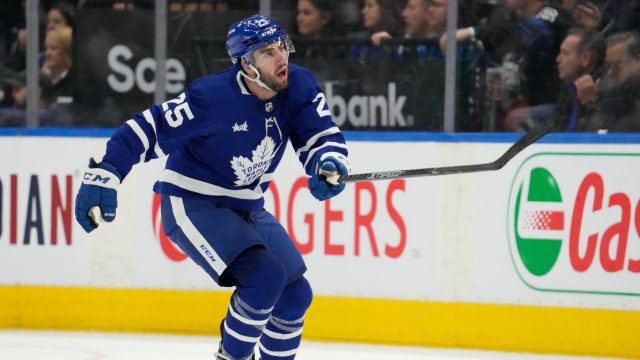TORONTO – It is not conjuring up a strawman argument to say that some fans of the Toronto Maple Leafs would like to see pre-season standout Easton Cowan get more run with the team, with some suggesting he even play his nine-game NHL maximum before being sent back to the OHL.
The tweets are out there, I promise.
The 18-year-old has been great — really great — prompting Leafs coach Sheldon Keefe to give this post-game quote after a pre-season game: “I was on the bench and tried to talk myself out of playing him, to be honest, because I got (Auston) Matthews, I got (David) Kämpf and I got (Pontus) Holmberg, all these guys that are older guys are here. They need to get their minutes, but it’s hard not to (play Cowan). Every time he was out there, he was making something happen. So, I got sick of talking myself out of it and started playing him more in the third.”
Keefe was excited, and fans are excited too.
Fans are also excited for Matthew Knies, who joined the Leafs with three games left in their 2022-23 regular season, where he quickly made it evident he was one of their best — if not their outright best — left winger. Anyone putting together potential Leafs lineups in the post-season included him in their elite top-six, almost universally, and he deserved it. He showed out last season, make no mistake.
Now …
There are few analogies more common in hockey than the idea that the regular season “is a marathon.” It is. You wake up, shower, skate, shower, nap, shower, play, shower, fly, sleep, wake up … you get the idea. You play 82 games across North America and rarely go more than a few nights without competing. You simply cannot play like it’s Game 7 of the Stanley Cup Final every night, hard as you might push yourself.
And, so, we do have “dog days” of the season. Game 54 against a bottom feeder, Game 58 in some snow-soaked small city … somewhere after Christmas but before the All-Star break, when guys are fine with a stat line of 0-and-0-for-0 if they can just get to bed without getting yelled at by their coach.
For established players, or guys on teams who know their playoff seeding early (see: the Maple Leafs, every year), sometimes a game is just another game. Pre-season is like that for the good players with contracts, of course, and there are a bevy of other reasons guys can’t or won’t red-line their effort every night.
There’s no greater proof of this point than the pace of playoff hockey. It’s always jarring in those first few playoff games, isn’t it? Guys are flying, boards are rattling, bodies are all over the ice, and suddenly someone’s bleeding.
The marathon is over, and it’s time to sprint.
When a young player steps in and thrives (whether in camp or mid-season), a coach is often trying to figure out: OK, how much of this player’s success is because he’s in “sprint” mode while everyone else is still pacing it out, and how excited should we be about what we’ve got here?
The stakes are not the same for every player in a given game.
An example is a guy Keefe mentioned in his quote, Pontus Holmberg. Holmberg played 37 games between November and mid-February, and was really good. But he didn’t seem like a guy who could maintain that same level of contribution when everyone else started sprinting too (at the beginning and end of the season), and he wound up back in the AHL. You have to be good enough to contribute when the stakes level out for each skater.
With Knies, it’s very easy to get excited about what he’ll bring to the Leafs this season. You’ve seen how good he can be, even when everyone else was sprinting in the playoffs (though it’s possible some of that fast, hard hockey did catch up to him against the Florida Panthers in Round 2).
So, should we expect Knies to maintain the level of value he demonstrated in his best games, when he has to settle into the marathon pace of the season? Knowing this is a real concern, should fans, and the team, temper expectations for him some?
Maybe it’s better to start him lower in the lineup with less pressure, where he can work his way up, rather than start too high and work his way down? (Nick Ritchie and Joe Thornton come to mind as recent “top-six” Leafs who couldn’t maintain the pace when everyone put the throttle down.)
And with Cowan, this guy is always a dog-on-a-bone type player, which is great. But when it’s whittled down to actual NHLers, and everyone comes out of the gate fast (and make no mistake, the opening pace when everyone is rested and excited is quick), is it fair to expect him to contribute in any meaningful way?
That’s a resounding no. You’d much rather see him get off to a great start in the OHL and establish his role with the chance to put up big numbers there. Just keeping up and getting by in the NHL isn’t anything as valuable as carrying the mail for one of Canada’s elite junior franchises.
(This whole thing is also a reminder that when a team is dragging mid-season, it’s a great time to call up some hungry AHLers who’ll give you playoff-level effort in games your regulars may sleepwalk through.)
Every pre-season, 32 fanbases get all riled up about a player who thrives by playing in sprint mode while the established NHL guys haven’t even kicked it into marathon-pace mode yet. And, every year, fans get excited about a variety of prospects, college kids like Knies, mid-season call-ups like Holmberg, and beyond.
But as much as hockey is a meritocracy, or at least should be, coaches know that not everybody enters each game with the same stakes, and they’re trying to build a roster that can win when everyone’s stakes are maxed out.
That’s why some of your favourite prospects, despite good showings at times, may not get the opportunity you think they deserve.




No comments:
Post a Comment